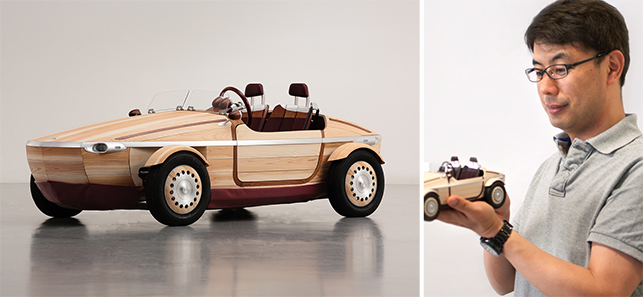
The Toyota Sestina and its designer Kenji Tsuji with a model of the concept car
The automotive world is one that’s often shrouded in secrecy as anyone that’s visited, or tried to visit, a styling studio will attest.
However, concept cars offer a brief glimpse into this world by allowing automotive manufacturers and their design teams the opportunity to show off ideas, thoughts and plans without worrying too much about protecting the collective crown jewels.
Toyota chose the Milan Design Week in April 2016 to debut its unique wooden concept car and the designer charged with its creation, Kenji Tsuji, was on hand to talk to the press.
DEVELOP3D: How did the project come about?
Kenji Tsuji: The Toyota corporate message is ‘Ever Better Cars’ and so we want to create cars that customers will enjoy. Our values are centred on both safety and environmental aspects, but when looking towards the future, we felt that we needed another value.
So we started thinking about what happens if you have a car for a long time. The beauty of it increases and you develop more affection for it as time goes on.
This is concept behind the Setsuna. It’s not just about the patina of age, but this way of thinking about how a car could become more beautiful the longer you own it.
D3D: What where the limitations of using wood?
KT: We chose wood because we thought it would most aptly embody the concept. But, before we made that decision, we asked ourselves, “What is the most appropriate material?”
We also realised that the material had to be OK to use in a car, so we carried out a lot of studies.
Once we decided on wood, it became clear that it presented a new set of challenges. The tree itself is living, so it has interesting properties that have to be considered when building a car.
Additionally, we had to consider factors such as the different seasons as well as changes in the material due to age and environmental conditions.
Working with this material also meant working with much larger tolerances (+/- 5mm). If the wood were to warp or shrink, we had to make sure that the material would still look good. And in the case of gaps, we had to make sure they were good looking gaps.
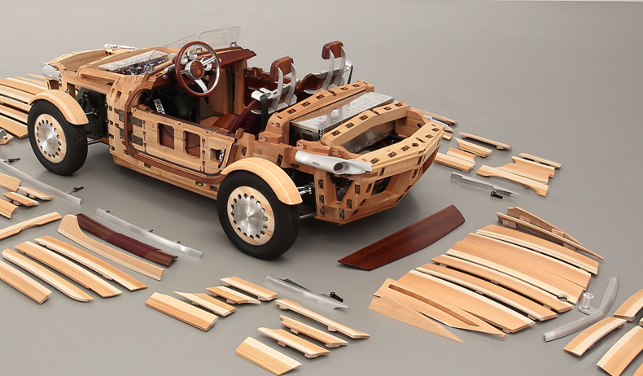
The Setsuna project uses a mix of wood stock native to Japan to solve structure, aesthetic and sensory requirements
D3D: Was is intentional for it to be similar to a boat?
KT: No, it was actually a coincidence. When looking at the material properties of wood and how it changes with age, we had nothing to base our references on so we had to start from scratch.
Where we got to, of course, was boat making, because that industry has a lot of knowledge and we took inspiration from that.
Although there are cars with wooden frames, such as Morgans, our thinking was not only in terms of concept design but how to make it out of this material too.
Saying that, using wood was not the instigator of this project, rather its use was the end result of our studies.
D3D: What wood did you decide to use?
KT: There are five main types of wood. The outer panels are made with Japanese cedar, which gives a softness of texture and appearance. Birch is used for the frame because it gives us the rigidity. Zelkova is used for the floor, again because of its high strength (Editor’s note: this is an elm, native to Japan).
Then for the seats and the instrument panel we’re using castor aralia. Finally, we’re also using Japanese cypress for the steering wheel, not only because of how it looks but also the smell.
D3D: Was the sensory experience of the smell of wood part of its appeal?
KT: The smell is something that we really wanted to focus on because this car is meant to imprint memories, so if you had to renew or refresh a part, you’d have to scrape the surface to reinvigorate that memory which is linked to the vehicle and your shared past.
It’s also worth noting that this car was sourced with new wood, but as it’s meant to be owned for 100 years before parts need to be replaced, the idea is that if the trees used to make it are replanted at the same time, that wood will be ready when these replacement parts need to be made.
D3D: Was this a fun project to work on alongside your more traditional work at Toyota?
KT: The overall experience was fun. I was originally working as an engineer on the Corolla, but this project was a lot about the conception and collaborating with colleagues during its design which made it more fun.
D3D: What were the practical outcomes?
KT: This car in particular isn’t going to market as it stands.
Having said that, when we designed it we specifically designed a crushable zone so that there is a degree of safety to it. Also, in terms of flammability of the parts, this is an electric vehicle so there’s a lower risk than an internal combustion engine, so should any part be burnt, we made sure that you can easily replace the parts.
Although it’s not to the level of a mass production car, we’ve done a basic level of verification for safety. What’s interesting about wood is that if you take the example of architecture, the exterior may catch fire but the centre doesn’t burn through and we took that on board.
By no stretch of the imagination do we think this car is perfect but the reason we exhibited it in Milan was to see how people would react to it. We want their feedback on this direction we’ve taken and whether it has a future. But the intention isn’t production.
D3D: Finally, now that you’ve been through the process, what lessons have you learnt and will these be transferred into production vehicles at all?
KT: This is my hope. If there are one or two features in this car that people overwhelmingly think is good or that they want to see in a car, then we can transfer that to our production vehicles.
I do wonder, if we had driverless cars this small, could we change or stir up the market? These types of cars are safer and they could have a real future.
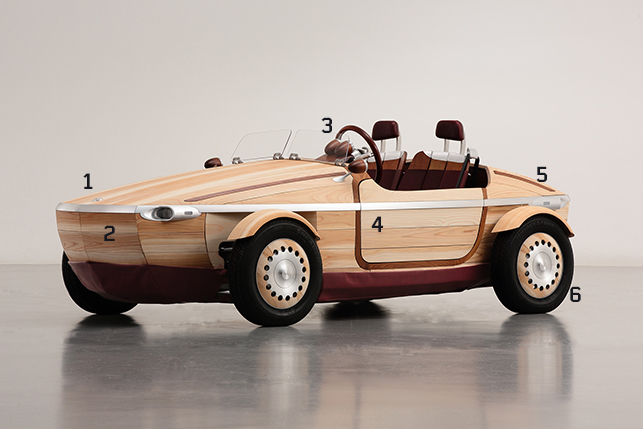
1 Emblem
In Setsuna’s circular, radial emblem captures the idea of “the accumulation of moments”. It represents both a clock face and the blooming of a flower, reflecting the designers’ wish for a growing relationship between car and family.
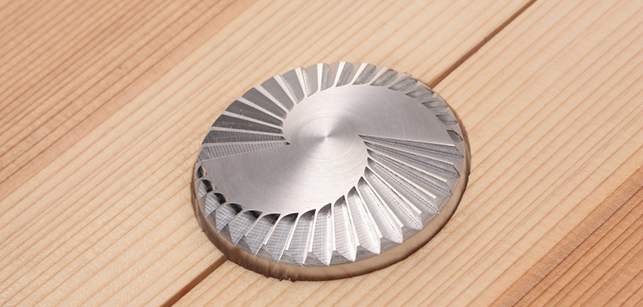
2 Hand finished
Lacquer finishing is applied by hand to bring out the beauty of the wood grain. Wipe-lacquering is applied to the door mirrors, seats, steering wheel and the banding lines on the bodywork.
This technique involves repeatedly applying the lacquer to the surface and wiping to set it along the grain of the wood to create a combined texture. Colour and intensity will change with use over time to give the vehicle a different appearance at different moments in its lifecycle
3 100 year clock
The dashboard clock not only marks the minutes and hours, it also counts the passing years. It’ll mark up to a century to record its years of constant service and its evolving role as a valued member of the family.
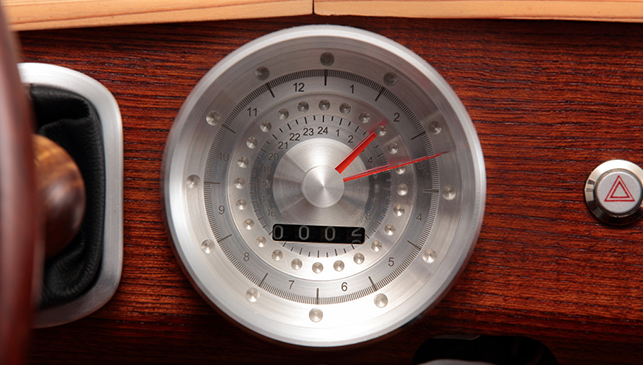
4 Okuriari & Kusabi
Sections of Setsuna have been crafted using traditional Japanese joinery techniques such as okuriari and kusabi. Okuriari allows the panels to be fitted without using nails, makes for stronger joints and allows minor changes to be made to the mortise and dovetail joints if they become worn over time. The joints in the car’s frame feature split tenons fastened to through-tenons that pass through several component parts in the frame to give a secure hold.
5 Native wood
Different types of wood were chosen for specific parts of the vehicle: Japanese cedar for the exterior panels; strong and rigid Japanese birch for the frame; hard-wearing Japanese zelkova for the seats; and smooth-textured castor aralia for the seats. The panels feature different grain patterns in the cedar, achieved with straight and crosscutting of the raw timber
6 Aluminium highlights
Aluminium is used for parts such as the wheel caps, steering wheel and seat frames, creating both contrast and harmony with Setsuna’s wooden features.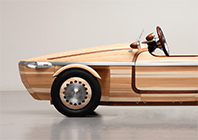
We talk with Kenji Tsuji, the mind behind the Toyota Setsuna concept car
Default






